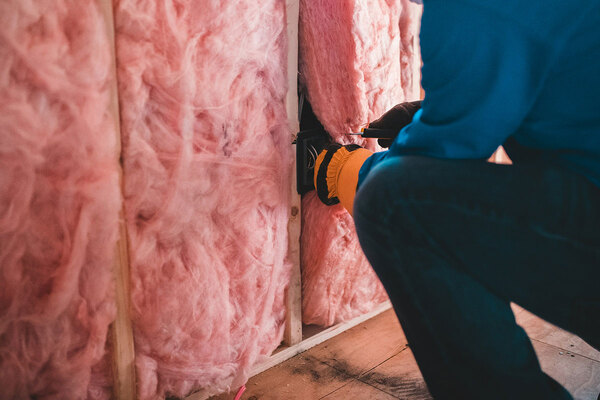Inside Housing visits one of the first landlords to win a C1 rating
Salford-based Salix Homes managed to get a top consumer rating from the English regulator despite facing significant challenges, including 20 high-rise buildings and mounting reports of repairs. Jenny Messenger visits to find out how Salix achieved its C1 grade
At the offices of Salix Homes in Salford, on a business park a few minutes’ walk from the city’s university, the landlord is cautiously keen to talk to Inside Housing.
In the boardroom, chief executive Sue Sutton, and tenant Charlotte Haines, who chairs the Salix Homes Customer Committee (SHCC), are explaining Salix’s route to being awarded the top consumer grade from the English regulator.
They are pleased – it is a “massive achievement”, Ms Sutton says – but she cannot help adding caveats to everything. “At no point do I ever want it to come across that we think we’re fantastic,” she says.
“Salix as a whole are too humble,” Ms Haines explains a little later. “They’ll do these amazing things, and rather than pat themselves on the back, they’ll say, ‘We need to move on to this. We need to fix this.’”
Yet for the English housing sector, C1 is instantly recognisable as a major accomplishment. It is the highest possible score on the Regulator of Social Housing’s (RSH) new ratings system for the consumer standards (see box, right). The official description seems prosaic – landlords that achieve C1 are “delivering the outcomes of the consumer standards”. But, for a sector that has been scrambling to rebuild its reputation after Grenfell and the disrepair crisis, the recognition that a landlord is delivering a reasonable level of service for tenants is highly sought after.
At the time of publication, the regulator had awarded nine C1 gradings, 13 C2s, 12 C3s and one C4. This August, Salix became one of the first landlords in the country to gain a C1. We wanted to find out what Salix has been doing right – and what other landlords can learn from it.
Thorough process
The four-year cycle of inspections meant that Ms Sutton and her team had already guessed they would be on the regulator’s list. The 8,000-home landlord found out for sure around the end of January that its inspection was coming up, even before the official launch of the consumer standards in February.
But Salix had already drawn up a decent approximation of the criteria it would be facing. Preparation had begun months and even years earlier. This meant that Salix could show a timeline of efforts to improve services – particularly on repairs, building safety and complaints.
“We’d heard the regulator speak many, many times, and the message was always, ‘Don’t wait. You absolutely know what you need to do, so don’t wait,’” Ms Sutton says.
Salix assessed itself on what it expected to find in the final standards. “We said, ‘Look, we don’t know if these are the final ones but they’re probably as near as damn it,’” Ms Sutton recalls.
At this point, Ms Haines jumps in. “I went to a customer engagement conference, and that’s when the ratings were explained a bit more,” she says. Other attendees were “really nervous”, but Ms Haines was looking forward to the prospect. “As a customer, I thought, ‘Well, we’ve got a three or four-year head start on this,’” she says. “I was excited.”
The lead inspector came to speak to Salix’s board before the inspection, to describe the process, and was in regular contact to clarify how things were going to work. The regulator also issued a document submission list, detailing all the evidence it needed to see.
Pulling the hundreds of requested documents together was a “mammoth task”, but Ms Sutton says she was comforted by the fact that the inspectors read everything and asked for additional pieces of information. “The inspection process was very, very thorough,” she says.
It kicked off in March, when inspectors from the RSH spent a day with the executive team and around half a day with the board chairs. The regulator also met in private with the SHCC and observed one of the customer group’s meetings.
“They had a very clear set of questions on all the standards. I don’t want to forget the G and the V ratings, because that was equally as challenging,” she says, adding a piece of advice: “Don’t try and hide anything.”
The regulator also confirmed Salix’s G1 and V2 ratings during the inspection.
“When [the regulator] came to speak to the customer committee, there were no officers in the room or anything,” Ms Haines points out. “[The SHCC] could have said anything, and they did.”
The regulator also spoke to the committee chairs. “They didn’t leave anything unturned,” Ms Haines says.
But the experience itself? “I was just petrified at that point. It’s scary, this room!” she laughs, gesturing to our rather formal surroundings.
Despite Salix’s preparation, the landlord did have concerns over specific issues – foremost, the growing backlog of repairs that had been building up post-pandemic. Residents were waiting for long periods of time for routine as well as emergency repairs, and Salix began overspending on its budget.
“Over the last two years, we’ve seen demand [for repairs] increase massively,” Ms Sutton says.
Deciding that a “root and branch” overhaul was needed, in 2021 the landlord drafted in the SHCC. Salix handed over all the information to the committee, which assessed the performance as “really rubbish”, Ms Sutton says candidly.
Salix contacted every person who had complained about repairs, held customer focus groups, spoke to frontline staff and operatives, and altered the budget to make sure there were enough resources allocated.
But when the regulator arrived, the landlord still felt that it was not ready.
“We knew what we needed to do,” says Ms Sutton, “but we weren’t there [meeting expectations on repairs] when the regulator came in and we knew we weren’t there, so we were very open, honest and transparent about that.”
During the inspection, she and her team were pushed to explain exactly when they expected to see improvements.
“They tracked performance during the month the inspection was going on, asking us a lot around, ‘If I’m a vulnerable customer or I have a disability, do I end up in that pot where it might take 90 days to do a routine repair?’” she says.
Salix’s efforts paid off. The regulator praised the landlord’s “effective, efficient and timely repairs service” and the changes it had made to improve what it offers residents.
Building safety has also been a priority for Salix, which has 20 high-rise blocks. Ms Sutton says that as the news about the Grenfell Tower fire broke in 2017, Salix acted quickly to contact residents and assess its blocks, finding eight with failed cladding.
How are the new consumer grades awarded?
The Social Housing (Regulation) Act 2023 introduced new consumer standards, under which housing associations and councils are inspected every four years. These cover four key areas: safety and quality of homes; transparency, influence and accountability; neighbourhood and community; and tenancy management.
They are rated from C1 to C4:
C1: The landlord has shown “that it identifies when issues occur and puts plans in place to remedy and minimise recurrence”.
C2: There are “some weaknesses in the landlord delivering the outcomes of the consumer standards” that could lead to “poor outcomes for tenants” if they are not addressed.
C3: There are “serious failings” and “significant improvement” is required, including creating “a plan that will drive significant change”.
C4: “Fundamental changes” must be made. “It is likely that the landlord has not shown the willingness and/or ability to put things right, and so we may decide to take enforcement action.” No organisation has yet been given a C4 grade.
On a tour of the landlord’s homes, we drive past two hulking tower blocks, Canon Hussey Court and Arthur Millwood Court. Built in the 1960s, the blocks had only been refurbished in 2014. Just a few years later, both were found to have failed aluminium composite material cladding after Grenfell, and the 15-storey buildings had to be stripped of their cladding, revealing shoddy work underneath. The original contractor later collapsed.
Remediation and safety works finished in 2021, and Salix has since become one of the first housing associations to achieve Building a Safer Future ‘Charter Champion’ status, an initiative that stemmed from Dame Judith Hackitt’s review.
A restructuring of how frontline services are delivered post-pandemic has seen Salix introduce a dedicated team of high-rise housing officers.
Salix also launched a customer engagement strategy focused on building safety and carried out more nuanced changes, discovering that life in a high rise brings with it a set of specific challenges.
“One of our [SHCC] committee members was in a high rise and did a mutual exchange to go into a house. There were a lot of things that were new to her, and different and confusing,” says Ms Haines.
These could be service charges, new door entry systems, different bins – and the way noise travels is unique to that way of living. Now, Salix makes sure these differences are explained to tenants in the welcome packs and tenancy agreements they are provided with – important changes, recognised by the regulator, that would not have been possible without working closely with residents.

Salix owes its recent success in good part to the SHCC, which Ms Sutton calls “one of our best achievements”.
Yet when Ms Haines joined the group, she was convinced it was just a box-ticking exercise.
“I literally said to one of the other customer committee members that I’d made a mistake – we’re just a tick-box. I was so upset,” she says.
Over time, Ms Haines changed her mind. “As things have gone on, and we’ve actually seen the things we’ve influenced being implemented within Salix, we are absolutely not a tick-box,” she says.
“When we finally got a vote on the board and the chair became a board member [in September 2023], that was such a huge win for the committee.”
Be open-minded
Formed at the start of 2020, the SHCC acts as a voice for residents and holds Salix to account over the services it provides. The committee chair has a place on the housing association’s board, and committee members are paid and given training, and have yearly appraisals.
A team of more than 30 residents, called community connectors, help to report back tenant issues, and there is a wider scrutiny pool of over 100 residents – ‘scrutineers’ – that the committee can call on to produce more detailed reports into specific areas, such as repairs or anti-social behaviour.
Does Ms Sutton have any advice for other chief executives facing an inspection? “Go into the inspection with a very open mind in terms of being able to showcase what [you] do well,” she says.
Part of the reason the inspection was a positive experience overall was that both parties felt they could be honest with one another. “They’re not coming to trick you,” she points out.
Ms Sutton will soon be stepping down as chief executive. She joined the organisation in 2008, when it was still an ALMO for Salford City Council (Salix became a housing association after residents voted for a stock transfer in 2015). Ms Sutton was promoted to chief executive in 2021.
Around the glossy boardroom table, the mood shifts when this is raised. Ms Haines is visibly unhappy. “I’m going to be very upset when you leave,” she says.
For Ms Sutton, it is “the right time to leave”, having steered the landlord to a strong position. “You don’t want a clone of me,” she jokes.
“We want someone who can keep bringing [the standards of] Salix up, but I can still say I’ll miss you,” Ms Haines shoots back, indignantly.
Ms Sutton laughs. For her, focusing too much on the regulator’s judgement is almost to miss the point. “It’s not that C1 rating for me, it’s the outcome for customers,” she says. “That’s what we’re here for.”
Recent longform articles by Jenny Messenger
Waqar Ahmed: the sector-disruptor who has helped L&Q grow
After more than three decades in housing, the ambitious finance director who drove some of the sector’s biggest mergers is retiring. He tells Jenny Messenger about his long list of financial firsts
Inside Housing visits one of the first landlords to win a C1 rating
Salford-based Salix Homes managed to get a top consumer rating from the English regulator despite facing significant challenges, including 20 high-rise buildings and mounting reports of repairs. Jenny Messenger visits to find out how Salix achieved its C1 grade
What is really happening with Section 106?
As developers raise the alarm about fewer social landlords buying Section 106 properties, Inside Housing’s exclusive data reveals how much affordable housing is delivered this way – and how much is in the pipeline. Jenny Messenger reports
In detail: what the NPPF changes mean for housing delivery
With the redrafted National Planning Policy Framework out for an eight-week consultation, James Riding and Jenny Messenger analyse the implications of a document that seeks to encourage large-scale housebuilding and reverse many of the previous government’s policies
Sign up for our regulation and legal newsletter
Already have an account? Click here to manage your newsletters













